-
 Bitcoin
Bitcoin $84,022.8967
2.34% -
 Ethereum
Ethereum $1,868.2838
2.77% -
 Tether USDt
Tether USDt $0.9999
0.00% -
 XRP
XRP $2.1453
3.05% -
 BNB
BNB $612.3358
2.78% -
 Solana
Solana $127.4412
2.71% -
 USDC
USDC $1.0001
-0.01% -
 Dogecoin
Dogecoin $0.1711
4.68% -
 Cardano
Cardano $0.6759
4.88% -
 TRON
TRON $0.2353
0.73% -
 Toncoin
Toncoin $4.0848
3.73% -
 Chainlink
Chainlink $14.0148
6.01% -
 UNUS SED LEO
UNUS SED LEO $9.3543
2.85% -
 Stellar
Stellar $0.2731
3.21% -
 Avalanche
Avalanche $19.4355
4.38% -
 Sui
Sui $2.3857
7.83% -
 Shiba Inu
Shiba Inu $0.0...01278
5.25% -
 Hedera
Hedera $0.1688
5.17% -
 Polkadot
Polkadot $4.1925
4.20% -
 Litecoin
Litecoin $84.6282
3.00% -
 MANTRA
MANTRA $6.3356
0.81% -
 Bitcoin Cash
Bitcoin Cash $312.8725
4.70% -
 Bitget Token
Bitget Token $4.6137
4.16% -
 Dai
Dai $0.9999
0.00% -
 Ethena USDe
Ethena USDe $0.9998
-0.03% -
 Pi
Pi $0.6993
0.19% -
 Hyperliquid
Hyperliquid $13.5365
7.54% -
 Monero
Monero $217.9467
1.18% -
 Uniswap
Uniswap $6.1376
4.34% -
 Aptos
Aptos $5.3585
3.13%
What is the "double-spending problem" in blockchain? How is it solved?
Blockchain uses cryptographic hashing, distributed consensus (like Proof-of-Work), and a decentralized network to prevent the double-spending problem—where the same cryptocurrency is spent twice—a critical vulnerability in digital currencies lacking central control.
Mar 19, 2025 at 01:25 am

Key Points:
- The double-spending problem refers to the risk of a single cryptocurrency being spent twice. This is a major challenge in digital currency systems that lack a central authority.
- Blockchain technology solves this problem through a combination of cryptographic hashing, distributed consensus mechanisms, and a decentralized network of nodes.
- Different consensus mechanisms (Proof-of-Work, Proof-of-Stake, etc.) offer varying levels of security and efficiency in preventing double-spending.
- Understanding the double-spending problem and its solution is crucial for comprehending the fundamental security of blockchain-based cryptocurrencies.
What is the "Double-Spending Problem" in Blockchain?
The double-spending problem is a fundamental challenge in digital currency systems. It arises because digital information, unlike physical cash, can be easily copied. A malicious actor could potentially spend the same cryptocurrency twice: once to a legitimate recipient, and then again to a different recipient, effectively stealing the funds from the first transaction. This undermines the entire concept of a secure and trustworthy digital currency. Without a robust solution, the value and utility of any cryptocurrency would be severely compromised.
How Blockchain Solves the Double-Spending Problem
Blockchain technology tackles the double-spending problem using a multi-faceted approach. The core of the solution lies in its decentralized, distributed ledger system. This means that every transaction is recorded on a public, shared ledger replicated across a vast network of computers (nodes).
- Cryptographic Hashing: Each block of transactions is linked to the previous block using cryptographic hashing. Altering any past transaction would require recalculating all subsequent hashes, making it computationally infeasible to tamper with the blockchain’s integrity.
- Distributed Consensus Mechanisms: These mechanisms ensure that all nodes agree on the valid sequence of transactions. The most prevalent is Proof-of-Work (PoW), where miners compete to solve complex mathematical problems to add new blocks to the chain. The first miner to solve the problem gets to add their block, and the network verifies its validity.
- Network Effect: The decentralized nature of the blockchain means there's no single point of failure. Even if some nodes are compromised, the majority of honest nodes will maintain the integrity of the blockchain, preventing fraudulent transactions from being accepted.
Proof-of-Work (PoW) in Detail
PoW is a computationally intensive process that requires miners to expend significant energy and resources to solve cryptographic puzzles. The first miner to solve the puzzle adds the next block of transactions to the blockchain. This process ensures that altering past transactions is extremely difficult because it would require controlling more than 50% of the network's hashing power (a 51% attack). While effective, PoW has drawbacks, such as high energy consumption and potential centralization risks around mining pools.
Alternative Consensus Mechanisms
Besides PoW, several alternative consensus mechanisms exist, each addressing the double-spending problem with different approaches and trade-offs:
- Proof-of-Stake (PoS): In PoS, the right to add new blocks is determined by the amount of cryptocurrency a node holds (its stake). This reduces energy consumption significantly compared to PoW.
- Delegated Proof-of-Stake (DPoS): DPoS allows token holders to vote for delegates who will validate transactions and add blocks. This offers faster transaction speeds and lower energy consumption than PoW.
- Proof-of-Authority (PoA): In PoA, a pre-selected set of validators, often known entities, are responsible for verifying and adding blocks. This mechanism prioritizes trust in the validators over computational power.
- Practical Byzantine Fault Tolerance (PBFT): PBFT is a deterministic consensus algorithm designed for smaller networks. It achieves consensus quickly and efficiently but scales poorly to larger networks.
Transaction Confirmation and the Double-Spending Window
Even with robust consensus mechanisms, there’s a small window of time, known as the "confirmation time," before a transaction is considered irreversible. This is because a malicious actor could theoretically create a competing blockchain with their fraudulent transaction before the legitimate transaction is widely confirmed. However, the probability of this happening decreases exponentially with each additional block added after the legitimate transaction. Most cryptocurrencies consider a transaction sufficiently confirmed after several blocks have been added on top.
The Role of Mining Pools in Preventing Double-Spending
Mining pools are groups of miners who combine their computing power to increase their chances of solving the PoW puzzle. While they enhance mining efficiency, they can also raise concerns about centralization. A large mining pool controlling a significant portion of the network’s hashing power could theoretically attempt a 51% attack. However, the vast majority of pools operate ethically, and the decentralized nature of the blockchain mitigates the risk to a large extent.
Frequently Asked Questions:
Q: Can the double-spending problem ever be completely eliminated?
A: While blockchain technology significantly mitigates the double-spending problem, it cannot be entirely eliminated. The possibility of a 51% attack, though incredibly difficult and expensive, always remains. The effectiveness of the solution depends on the security and decentralization of the specific blockchain network.
Q: How does the number of confirmations affect the security of a transaction?
A: More confirmations increase the security of a transaction. Each additional block added after a transaction makes it exponentially harder for a malicious actor to reverse it. The required number of confirmations varies depending on the cryptocurrency and the risk tolerance.
Q: Are all cryptocurrencies equally resistant to double-spending?
A: No, different cryptocurrencies use different consensus mechanisms and have varying levels of security. The choice of consensus mechanism, network size, and the overall security practices of the cryptocurrency project all contribute to its resistance to double-spending.
Disclaimer:info@kdj.com
The information provided is not trading advice. kdj.com does not assume any responsibility for any investments made based on the information provided in this article. Cryptocurrencies are highly volatile and it is highly recommended that you invest with caution after thorough research!
If you believe that the content used on this website infringes your copyright, please contact us immediately (info@kdj.com) and we will delete it promptly.
- South Korea Cracks the Whip on Unregistered Digital Asset Exchanges, Targeting Bans on KuCoin, BitMEX, and Others
- 2025-04-01 20:10:12
- Shytoshi Kusama's Cryptic New Location Hints at Big Changes Coming to the SHIB Ecosystem
- 2025-04-01 20:10:12
- The Best New Meme Coins to Join Now: BTFD Coin, Gigachad, and More
- 2025-04-01 20:05:12
- Russian Darknet Markets Dominate Bitcoin and TRON Drug Sales, TRM Labs Says
- 2025-04-01 20:05:12
- Bitcoin (BTC) Selling Pressure Has Dropped Sharply, Suggesting a Period of Consolidation
- 2025-04-01 20:00:12
- Strategy (MSTR) Acquires 22,048 Bitcoins (BTC) for $1.92 Billion at an Average Price of $86,969 per BTC
- 2025-04-01 20:00:12
Related knowledge
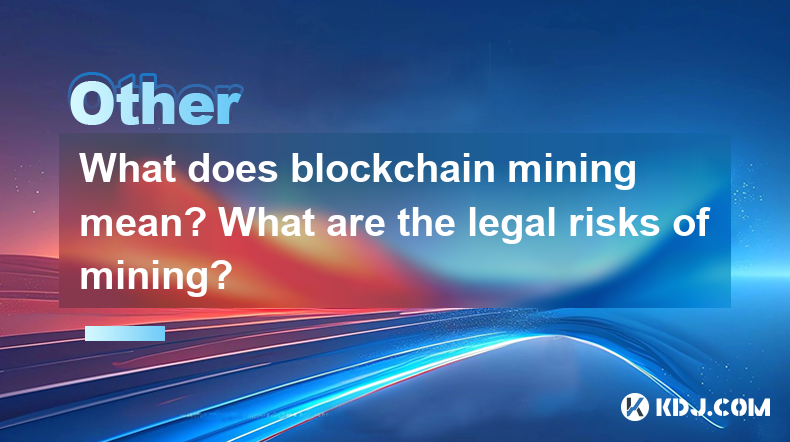
What does blockchain mining mean? What are the legal risks of mining?
Mar 31,2025 at 05:07pm
Blockchain mining is the process by which transactions are verified and added to the public ledger, known as the blockchain. Miners use powerful computers to solve complex mathematical problems, which, once solved, allow them to add a block of transactions to the blockchain. In return, miners are rewarded with cryptocurrency, typically Bitcoin. This pro...
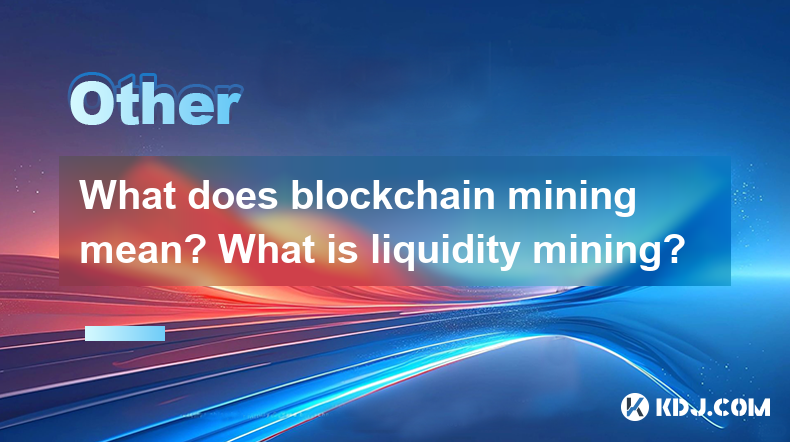
What does blockchain mining mean? What is liquidity mining?
Apr 01,2025 at 12:07am
What is Blockchain Mining?Blockchain mining is a critical process in the world of cryptocurrencies, particularly for networks like Bitcoin and Ethereum. It involves the use of computational power to solve complex mathematical problems, which in turn validates transactions and adds them to the blockchain. Miners are incentivized through rewards, typicall...
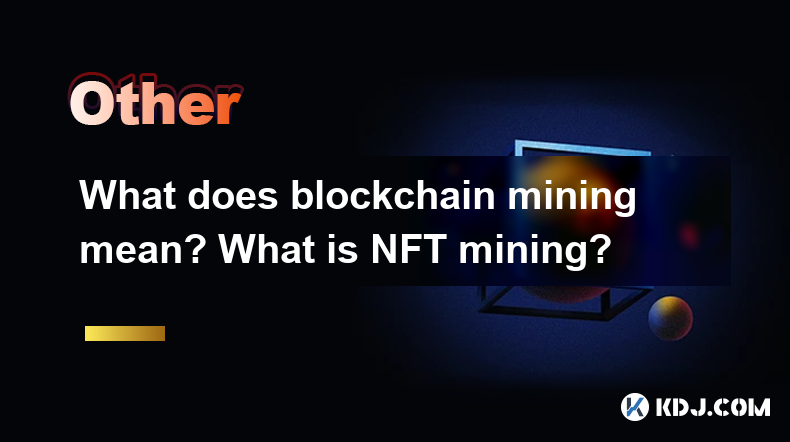
What does blockchain mining mean? What is NFT mining?
Mar 31,2025 at 04:07pm
Blockchain mining is a crucial process in the world of cryptocurrencies, particularly for networks like Bitcoin and Ethereum. It involves verifying transactions and adding them to the blockchain, a decentralized ledger. Miners use powerful computers to solve complex mathematical problems, which, when solved, allow them to add a block of transactions to ...

What does blockchain mining mean? What is the difference between cold wallets and hot wallets for mining?
Apr 01,2025 at 07:56am
Blockchain mining is a critical process in the world of cryptocurrencies. It involves verifying transactions and adding them to the blockchain, a decentralized ledger. Miners use powerful computers to solve complex mathematical problems, which, when solved, allow them to add a block of transactions to the blockchain. In return, miners are rewarded with ...
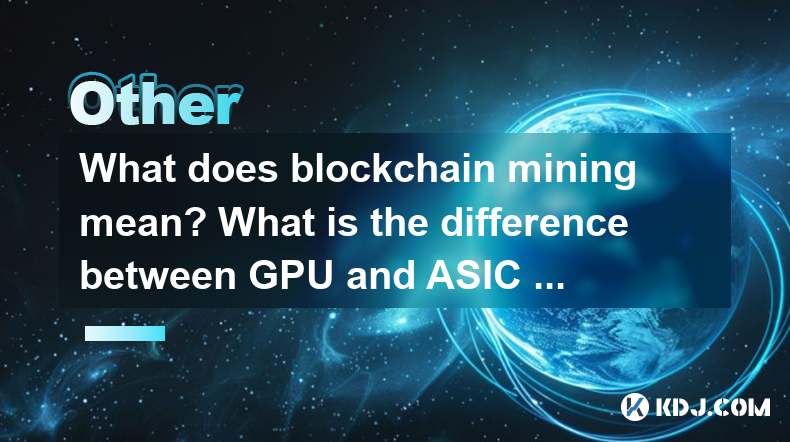
What does blockchain mining mean? What is the difference between GPU and ASIC mining?
Apr 01,2025 at 11:56am
Blockchain mining is a crucial process in the world of cryptocurrencies, particularly for networks like Bitcoin and Ethereum. At its core, mining involves solving complex mathematical problems to validate transactions and add them to the blockchain, a decentralized ledger. Miners compete to solve these problems, and the first to succeed is rewarded with...
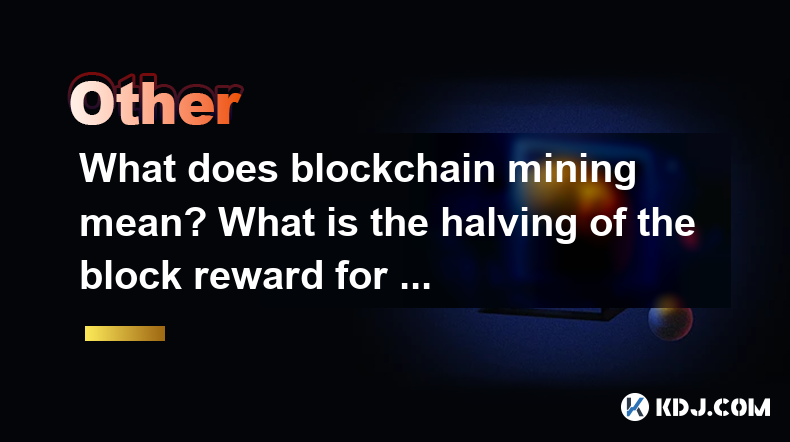
What does blockchain mining mean? What is the halving of the block reward for mining?
Mar 31,2025 at 03:43pm
Blockchain mining is a crucial process in the world of cryptocurrencies, particularly for networks like Bitcoin. It involves solving complex mathematical problems to validate transactions and add them to the blockchain, a public ledger of all cryptocurrency transactions. Miners use powerful computers to compete in solving these problems, and the first t...

What does blockchain mining mean? What are the legal risks of mining?
Mar 31,2025 at 05:07pm
Blockchain mining is the process by which transactions are verified and added to the public ledger, known as the blockchain. Miners use powerful computers to solve complex mathematical problems, which, once solved, allow them to add a block of transactions to the blockchain. In return, miners are rewarded with cryptocurrency, typically Bitcoin. This pro...

What does blockchain mining mean? What is liquidity mining?
Apr 01,2025 at 12:07am
What is Blockchain Mining?Blockchain mining is a critical process in the world of cryptocurrencies, particularly for networks like Bitcoin and Ethereum. It involves the use of computational power to solve complex mathematical problems, which in turn validates transactions and adds them to the blockchain. Miners are incentivized through rewards, typicall...

What does blockchain mining mean? What is NFT mining?
Mar 31,2025 at 04:07pm
Blockchain mining is a crucial process in the world of cryptocurrencies, particularly for networks like Bitcoin and Ethereum. It involves verifying transactions and adding them to the blockchain, a decentralized ledger. Miners use powerful computers to solve complex mathematical problems, which, when solved, allow them to add a block of transactions to ...

What does blockchain mining mean? What is the difference between cold wallets and hot wallets for mining?
Apr 01,2025 at 07:56am
Blockchain mining is a critical process in the world of cryptocurrencies. It involves verifying transactions and adding them to the blockchain, a decentralized ledger. Miners use powerful computers to solve complex mathematical problems, which, when solved, allow them to add a block of transactions to the blockchain. In return, miners are rewarded with ...

What does blockchain mining mean? What is the difference between GPU and ASIC mining?
Apr 01,2025 at 11:56am
Blockchain mining is a crucial process in the world of cryptocurrencies, particularly for networks like Bitcoin and Ethereum. At its core, mining involves solving complex mathematical problems to validate transactions and add them to the blockchain, a decentralized ledger. Miners compete to solve these problems, and the first to succeed is rewarded with...

What does blockchain mining mean? What is the halving of the block reward for mining?
Mar 31,2025 at 03:43pm
Blockchain mining is a crucial process in the world of cryptocurrencies, particularly for networks like Bitcoin. It involves solving complex mathematical problems to validate transactions and add them to the blockchain, a public ledger of all cryptocurrency transactions. Miners use powerful computers to compete in solving these problems, and the first t...
See all articles























































































